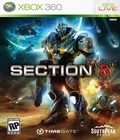The more games I play on HD consoles in this generation, the more I believe gaming has reached a watershed moment, when game designers can technically realize their visions without making numerous comprises to the raw performance limitations of hardware and software. It's a bit like what George Lucas said before he remade "Star Wars" episodes IV-VI — at least the special effects elements of the films — and then went on to make prequels in episodes I-III. As fans of the original "Star Wars" films in their first theatrically released versions will tell you, the technology to realize grand visions is a very important element, but ultimately, it's the depth of vision that matters most.
So it goes with SouthPeak's Section 8. Using the exceptional facility of the Unreal Engine as implemented on Xbox 360, the game looks quite good and plays smoothly. Except for some brief instances of third-person, rear-camera perspective, it's a first-person game, and the weapons and character models, view distances, and overall visuals look quite good, if completely uninspired. The character animations are above average for this sort of space-marine shooter, and there are some nice particle effects around things, like exploding grenades. Everything from the weapon types to the armored suits of the 8th Fleet soldiers look as if they've been pulled out of a generic game developer catalog, under the category heading "Marines, Space — Armaments and Costumes."
Likewise, the game's natural environments and structures probably came out of the same catalog, perhaps under the heading "Planet Surfaces, Anonymous and Desolate" or "Futuristic Military Installations, Cracker-box and Monotonous." Nothing about Section 8 is bad; it's just all so bland and unoriginal. The title is plainly derivative of what Halo 3 did best — some would argue that perhaps the original Halo did it best — and scores of games have since mimicked the formula, in manners running the gamut from execrable to commendable. Oh boy, was I tired of World War II shooters until Call of Duty: World at War came along, placing an exceptional exclamation mark on the subgenre I was obliged to play. Oh boy, I am sick of space-marine shooters, a subgenre still awaiting its late-entry highlight. Perhaps such a thing, if it ever arrives, will come from the hands of the acknowledged masters, in Halo 3: ODST or the currently rather nebulous Halo: Reach. Perhaps not; maybe it can come out of a new IP developed by a small shop. But in any case, Section 8, no matter how technically competent, is for this day and age relevant only as an example of the futility in publishing a vanilla implementation of an ubiquitous premise in a field now crowded with really good games.
Section 8's solo campaign is centered on an 8th Armored Fleet trooper named Corde, and is therefore called Corde's Story. It's not insignificant that the Corde's Story option in the main menu comes after both the multiplayer and instant action modes; clearly, the solo campaign was designed out of the game's core multiplayer model. More commonly, shooter multiplayer modes are derived from the campaign, wedged in as an afterthought, or created by a team working almost exclusively on the multiplayer component.
In Section 8, the solo campaign smacks of both afterthought and distillation of the multiplayer action. This alone wouldn't be so damning if the title's multiplayer design weren't so very, very run-of-the-mill. To watch the game's opening cinematic, exciting and nicely executed, you expect a far more thrilling solo experience to follow. Instead, Corde's Story, the tale of the 8th Armored Fleet versus the enemy Arm of Orion faction, is pedestrian and emotionally flat, each mission nothing more than a string of lackluster objectives yielding progress-saving checkpoints and resupplies, before moving you on to do the very same thing under slightly different circumstances.
The drop procedure at mission start and respawn is a bit novel and fun to watch, but it gets old quickly, especially as it consumes time in the solo campaign when, after dying or switching class, you'd much rather quickly pop back to life at the last checkpoint. The wide-open appearance of the mission environments doesn't help much because it's just that — merely appearance. Areas visible on the HUD from the player's field of vision but with red and black crosshatching are forbidden; straying into them will trigger a few seconds of countdown warning and then kill you without ceremony.
The game is class-based, and there are fairly fast requirements to use a variety of different classes in the solo campaign. Again so very reminiscent of multiplayer mode, from the always-accessible Dropship menu you can, anytime during the course of a mission, choose to self-destruct and respawn as another available class. The problem with the classes in the campaign is that their loadouts are too heavy at the start. Choose assault, drop into the action, and you're a walking war machine; there's no sense of struggle in story progression to reach the point where each class is awarded more powerful, interesting weapons and tools. I'm not a big fan of shooters that initially equip you with a toothpick, paper clip and box of Kleenex, and then leave you underarmed like that for a long time. That's just discouraging.
Yet, on the other hand, if, throughout the first couple of missions, I feel that I'm entirely as stoked and supreme as I'll ever get, I feel like yelling at the game's director, "But what's my motivation?" Some games are obviously designed too difficult in the early missions, and to balance difficulty they start you as a badass; but these titles often make up for it by providing creative, diverse missions and an engaging, well-paced story. Alas, Section 8's mission design is as bland as its presentation and plot.
Unfortunately, the in-game, voice-over tutorial is all but worthless; it provides the occasional helpful hint when arriving at new mission objectives for the first time, but seasoned and novice players alike must consult the printed manual or in-game options screens for proper controller layout. Also, the controller assignments cannot be customized, although the mandatory scheme works well enough.
The solo campaign provides a fair amount of regular action as well as some decent vehicle interludes, ride-along episodes expected in shooter campaigns these days. Section 8 also provides three vaguely unique gameplay mechanics in both solo and online multiplayer. You can sprint by pressing down on the left thumbstick; you can sprint really fast by holding down the left thumbstick for a few moments. You can't shoot when sprinting, but your quick progress across the map makes for a difficult target, anyway.
At this point, the game enters a third-person, rear-camera perspective for better navigation; bear in mind, sprinting into a solid object won't hurt you, but it will stall you right there with a thump. Corde, his fellow 8th Armored Fleet troopers and the Arm of Orion opposition all have jet-packs, more like jump-packs, that provide a limited vertical boost — jet-packs recharge with disuse — for evading attacks and vaulting obstructions you otherwise must circumnavigate. The jet-packs are something of a refinement of all the ridiculous high-jumping evasive action popular in online shooters since at least the Team Fortress mod for the original PC version of Quake.
In this context, the height of the jumps makes sense, as they're power-assisted. Also, when you use the left trigger to zoom/aim and fire on target at an opponent for a few moments, you'll often get the option to press the A button and lock on. Jumping will briefly get you out of dire firefight situations, but if your opponent has locked you in his sights, you're not completely out of harm's way. Of course, per usual, this feature is clearly most suited to multiplayer action.
The last special element to Section 8 is the ability to call up a "store" with the d-pad. You earn credits you can spend at the store via progressing in the solo campaign or doing well at multiplayer. Class-specific items in the store provide equipment to complete objectives, along with upgrades and extra items to enhance the power of your current player class. The store is generally available throughout all gameplay, even online multiplayer, though all items may not be in inventory all the time. It's a nice feature, but try grocery shopping in the middle of a combat zone; it often makes for a chaotic, frustrating experience.
So what about multiplayer, anyway? Essentially, if you've played Corde's Story, you've experienced both Instant Action — multiplayer against AI bots of fairly poor skill — and the full online multiplayer game. Likewise, go straight to the multiplayer, and you may as well have played all the way through Corde's Story. If you don't care about the story progression and other offline Xbox Live Achievements, especially considering many shooter fans go straight for multiplayer, anyway, you might just start Section 8 in online battles. Many players will quickly abandon the story mode to do just that.
Constant refinements and high-quality control in the Xbox Live environment have made it so that it's been a long time since I've had a consistently technically flawed online experience with Xbox 360. Section 8 plays smoothly, fairly devoid of game-ruining lag — and the controls work as well against live opponents as they do in the offline modes. But there's only one very common sort of multiplayer experience. It's all what the developers call Conquest, team-based, stringing together objectives to earn points, the same deal as the campaign, played on a handful of staid, cookie-cutter maps that could definitely use much better cover. Kneeling doesn't do much to spare your hide, and you can't lie prone. Getting caught out in the open by a couple of opponents with even passable shooter skills is a signed death warrant.
Section 8 is difficult to recommend to anyone but fans of the space-marine shooter subgenre. That's what I'd normally do, with caveats, as a filler between releases of their favorite game type. However, with Halo: ODST mere days away, I find Section 8 almost impossible to recommend to anyone. Sure, it's possible that ODST just won't measure up to the franchise's legacy, but, if I had to bet, I'd surely bet on a new Halo title over Section 8. It's a quality franchise, worth waiting to compare with other similar offerings, and, frankly, even if ODST turns out only an average game, it will still rob most of Section 8's Xbox Live online player base. By the end of next week, the distant, empty-looking planets of the game's futuristic setting really will be just about totally depopulated.
Score: 6.5/10More articles about Section 8











 Section 8 is a futuristic first person shooter that brings strategy and tactics to the genre in a game where players can modify the battlefield on the fly. In Section 8 you are part of an elite infantry squad with a penchant for taking on suicide missions that no one else will tackle.
Section 8 is a futuristic first person shooter that brings strategy and tactics to the genre in a game where players can modify the battlefield on the fly. In Section 8 you are part of an elite infantry squad with a penchant for taking on suicide missions that no one else will tackle.



















































